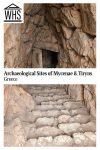Archaeological Sites of Mycenae and Tiryns
By Rachel Heller
What are the Archaeological Sites of Mycenae and Tiryns?
This UNESCO site is really two sites about 20 kilometers (12 miles) apart, both of them ruins of important ancient cities in the Peloponnese in Greece. The Mycenaean civilization originated in the Bronze Age, about 1750-1050 BC, according to Wikipedia, and is considered an early phase of Ancient Greek civilization. Mycenae and Tiryns were two of Mycenaean civilization’s greatest cities.
Disclosure: This article contains affiliate links. Making a purchase through an affiliate link will mean a small commission for this website. This will not affect your price. Privacy policy.
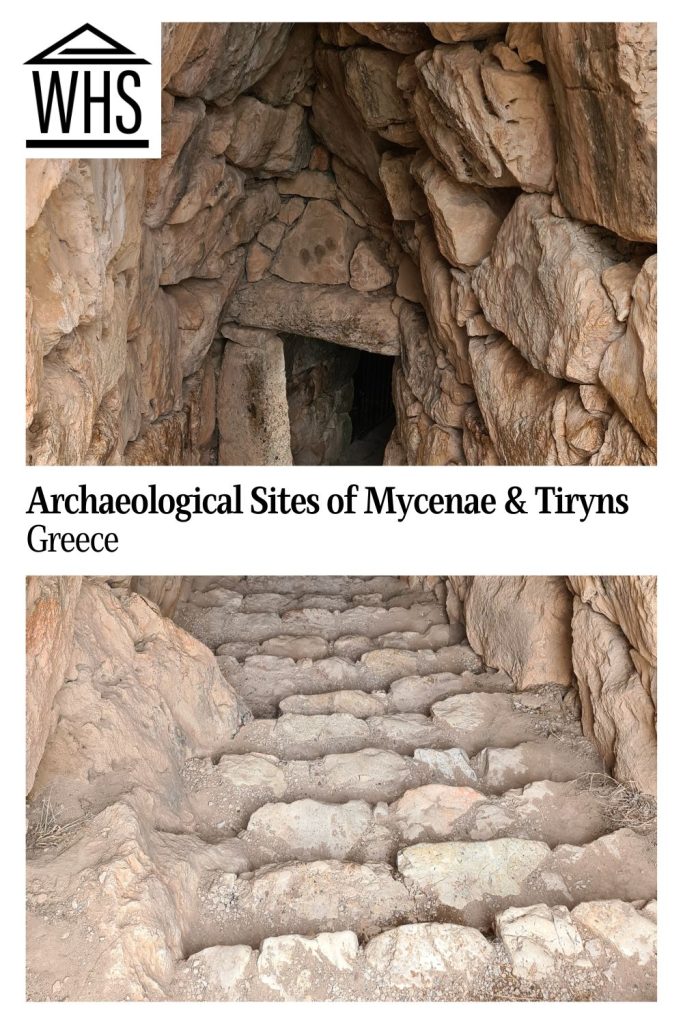
Mycenae
Mycenae is the better-known of the two sites because of its location, perched dramatically high on top of a mountain. It contains structures dating to the 17th to the 13th centuries BC and had a population of about 30,000 at its peak. Mycenae was essentially abandoned in the 12th century BC after a fire, though people lived there centuries longer until it was conquered by Argos in 498 BC, though it never regained importance in the Ancient Greek period.
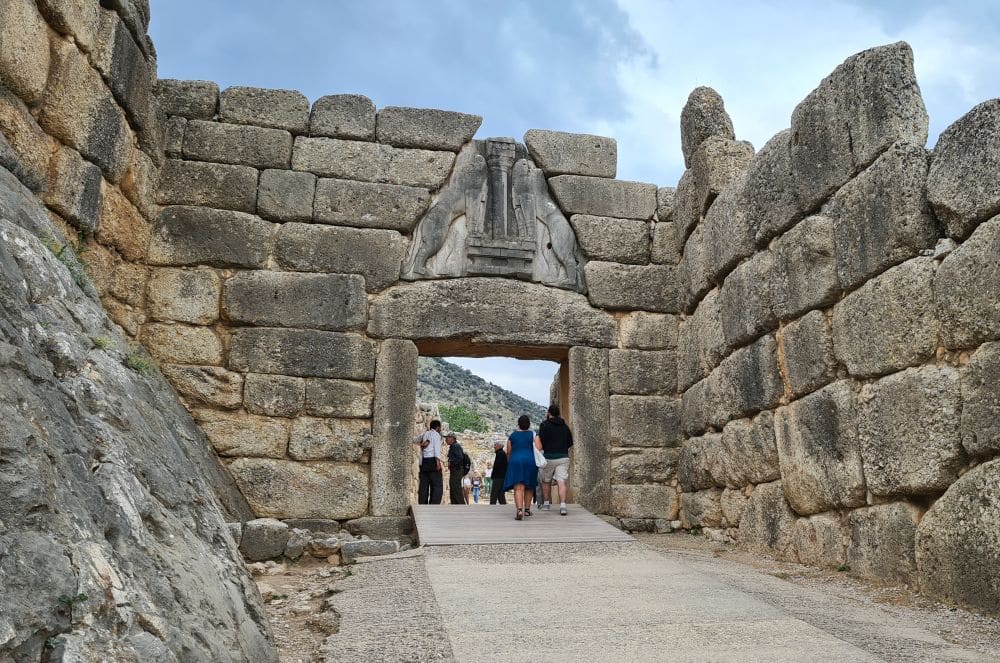
Tiryns
While Tiryns is less dramatically located, it contains even older architectural remains, dating to the Early Bronze Age (3000 BC), with more added over the next 1000-1500 years. At its height it had a population of about 10,000. It declined with the Mycenaean civilization.
Why are the Archaeological Sites of Mycenae and Tiryns a UNESCO World Heritage site?
These ancient cities were added to the UNESCO list for a number of different reasons. Some elements of the architecture – particularly Mycenae’s Lion Gate and the walls of Tiryns – “are outstanding examples of human creative genius,” according to UNESCO. The Mycenaean civilization influenced the later development of Ancient Greece in terms of architecture and “contemporary cultural forms.” They are the best remaining traces of Mycenaean civilization, and serve to represent that piece of Greece’s history.
Additionally, Mycenae is linked to important Greek myths and stories of its rulers like Klytaimnestra, Ifigeneia, Elektra and Orestes. It is the home of Agamemnon and appears in both the Iliad and the Odyssey, “which have influenced European art and literature for more than three millennia.”
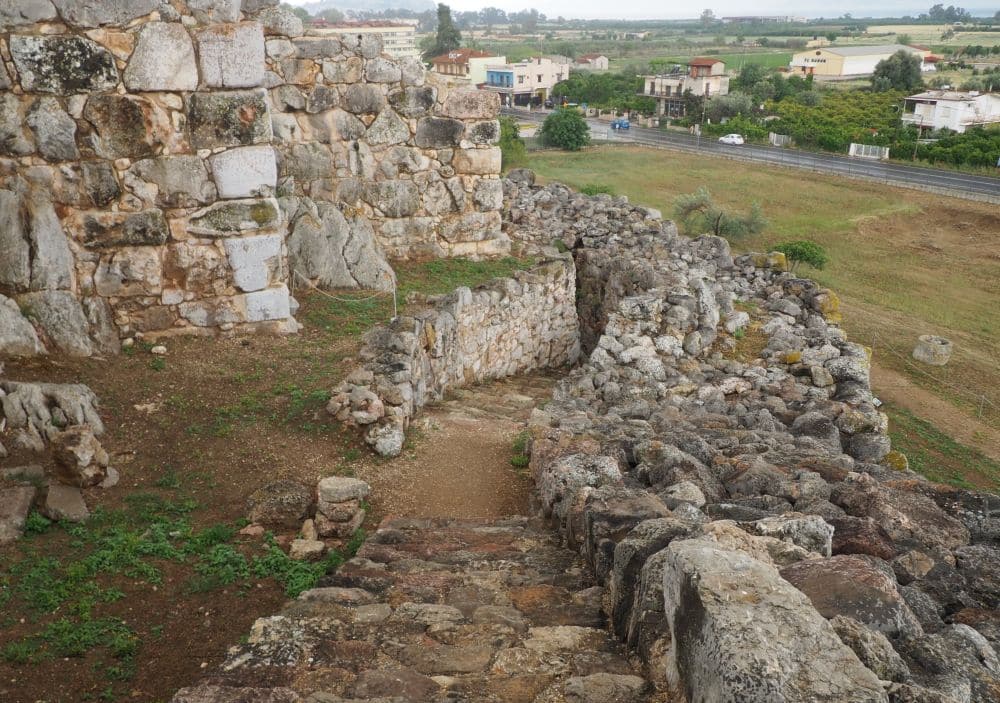
What can you expect on a visit to Mycenae and Tiryns?
Mycenae
On arrival at the entrance to the Mycenae site, once you park, you’ll see very little of the ruins – it looks like a mere pile of rocks on top of a hill. As you climb the path to the ruins, though, the extent of the walls gradually reveals itself. The path takes you between two high walls made of massive rocks (called “Cyclopian” walls) to the imposing Lion’s Gate (see photo above). Beyond the Lion’s Gate more of the ruins become visible, as does the dramatic view from this high on the hill.
To your right is Grave Circle A, one of the grave pits that have revealed much about the ancient Mycenaeans. The sheer size of the pit isn’t immediately clear until you approach it and realize that you can walk around the top of its round wall, between two rows of vertical and massive rocks.
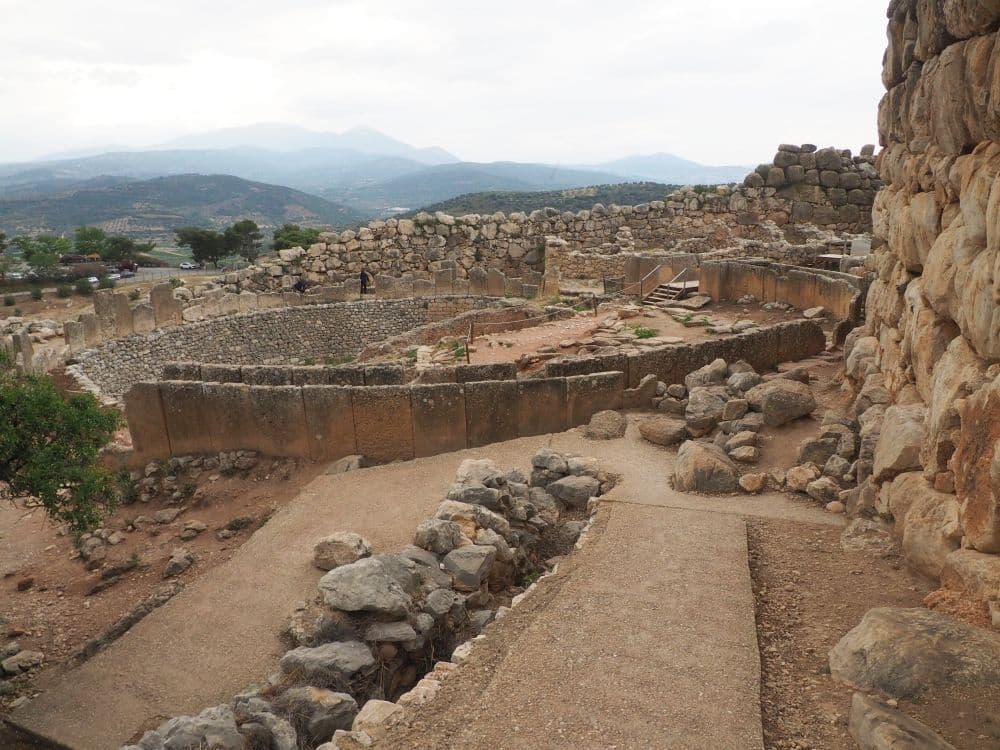
Continuing up the hill, you’ll get more of the view and get a clearer picture of how large this fortress and palace once was, as well as how many dwellings once surrounded it. Their outlines are visible, clustered both inside and outside the remaining walls. Signposts explain here and there what once stood in each section, building up an understanding of a complicated and thriving city.
Tiryns
Presumably Tiryns is less visited because it is in a less dramatic location. Yet the ancient city’s massive and high walls make quite an impression as you approach and reach the parking lot outside. To me it was even more impressive than Mycenae, perhaps because of those complete and relatively intact walls. In both cases, the walls used unusually large rocks, not closely fitted together, with no mortar, yet still standing. I also realized, on climbing to the highest point inside the ruined fortress, that it was built up so high within the walls to allow a commanding view of the surrounding countryside.
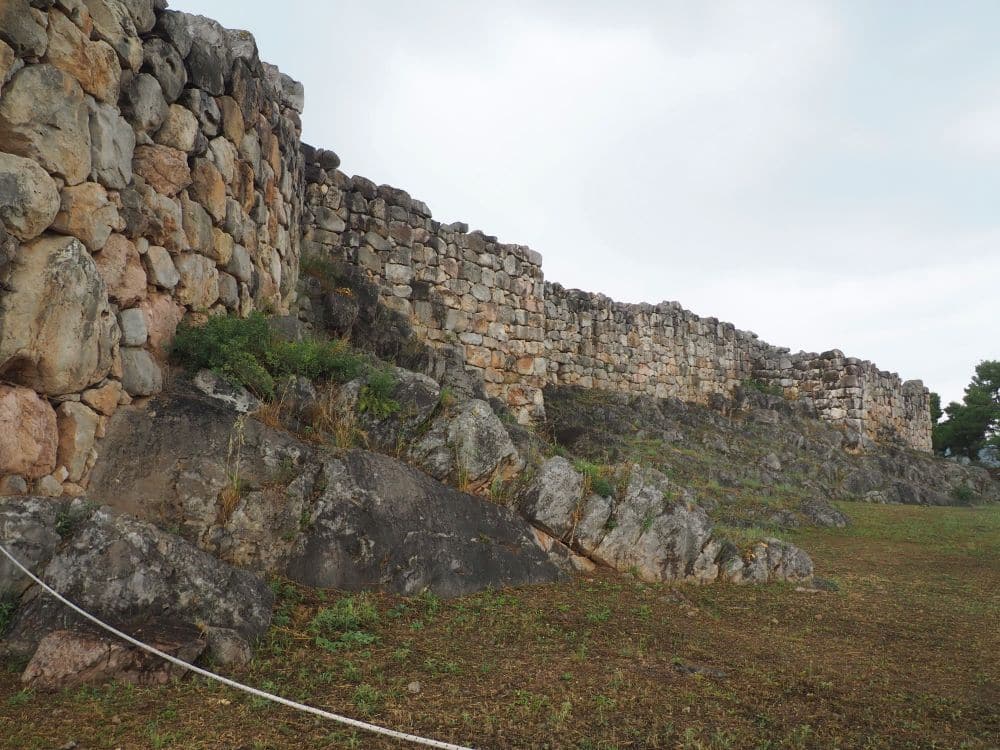
Like at Mycenae, you’ll see the remaining foundations of a castle and dwellings, but the main attraction here is the walls.
There aren’t many limitations on where visitors can walk in Tiryns. It was both a fortress and a crowded town, and the outlines of many structures combined with signage here and there help visitors understand what the city once must have looked like.
Are Mycenae and/or Tiryns worth visiting?
For me, they were definitely worth visiting, mostly because I’d never learned anything about the Myceneans in school – only about the later Ancient Greek civilization. It’s worth visiting if you’re a history geek like me or if you’ve read the Iliad and/or the Odyssey and would like to see where parts of these ancient stories took place. If not, it might not be worth the effort.
If you happen to be in the area, Mycenae might be worth visiting even if history isn’t your thing: the views are breathtaking. I visited on a rainy day and the views were gorgeous. I can only imagine how much more impressive the views are on a clear day.
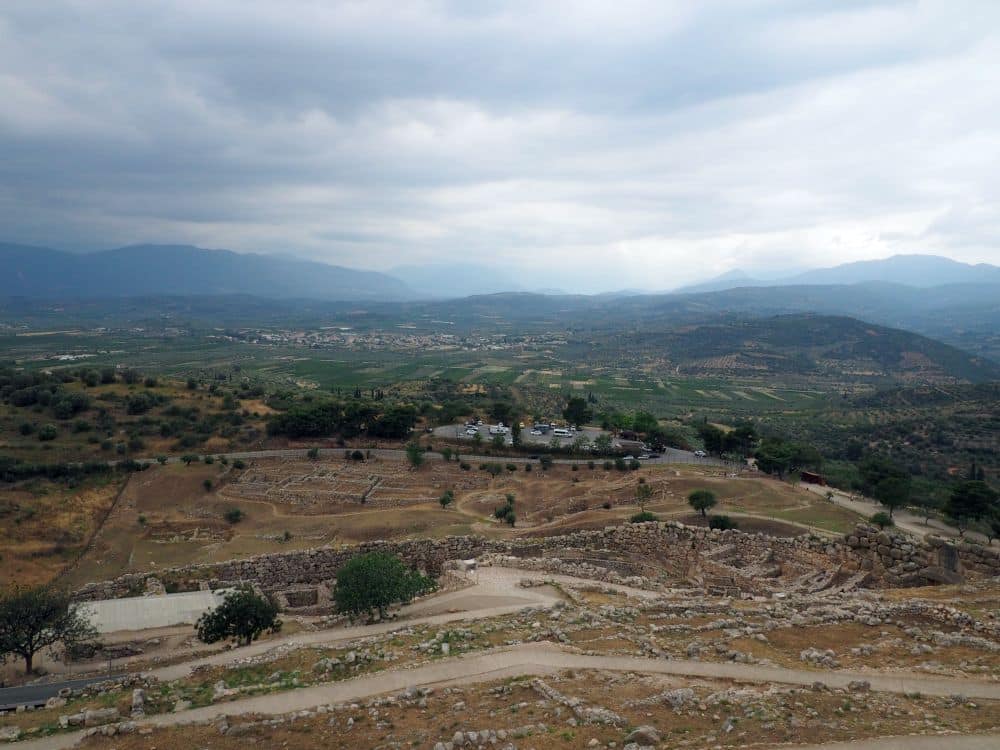
Tips for visiting Mycenae and/or Tiryns
Mycenae is far more popular as a destination than Tiryns, and it has become a standard part of many tours. That means you’ll have to deal with more crowds as buses unload and reload. Try to arrive early before the bus groups or try the last hour before it closes. Tiryns, on the other hand, won’t get very crowded.
Compare rental car prices here.
Neither site is particularly child-friendly. Kids might enjoy clambering over rocks or exploring down staircases, but I doubt it would hold their interest for long.
There are gravel paths through both sets of ruins, but to see all the ruins involves lots of steps up and down and plenty of uneven surfaces. Wear sturdy shoes, not flip flops or heels. Bring water, especially in summer, which can be unbearably hot, and wear sun lotion, sunglasses and a sunhat.
Neither site is very wheelchair accessible after the initial approach.
Many tours in the Peloponnese include Mycenae as a quick stop. If you’re traveling on your own in a rental car, you could do the same. If you’re not sure whether it’s worth visiting, but you’re planning a visit to Nafplion, then you might as well stop at Tiryns, which is only about a 5-minute drive (4 km or 2.5 miles) from Nafplion old city. I hired a taxi and negotiated a price to combine a visit to Tiryns with a visit to Palamidi Fortress that looms over Nafplion. Both stops were easy to do in one afternoon. I saw Mycenae as part of a Peloponnese tour organized by Audley Travel, then arranged these two sites myself.
Tours that include Mycenae – but not Tiryns – are available from Athens or from Nafplion.
Where are Mycenae and Tiryns?
Most people visiting Mycenae, if they’re not taking a day trip from Athens, stay in the pretty little town of Nafplion. I stayed at the pretty little 4-star hotel called Grand Sarai, right in the old town, as part of a sponsored trip by Audley Travel. There are plenty of other accommodations there, though, in all price ranges. Use the map below:
Mycenae
Mycenae is a half-hour drive north of Nafplion by car. If you prefer public transportation, there are buses from Nafplion that also take about a half hour. From Argos it’s only 15 minutes by bus, while from Athens it’s more like an hour and a half.
Tiryns
As mentioned above, Tiryns is only about a 5-minute drive north of Nafplio, or you could walk it in less than an hour. Otherwise, take a taxi, making sure to negotiate the price first, or a bus takes about 10 minutes.
For information on opening hours and admissions fees, see the official websites for Mycenae or Tiryns.
Have you been to Mycenae and/or Tiryns? If so, do you have any additional information or advice about this UNESCO World Heritage site? Please add your comments below!

